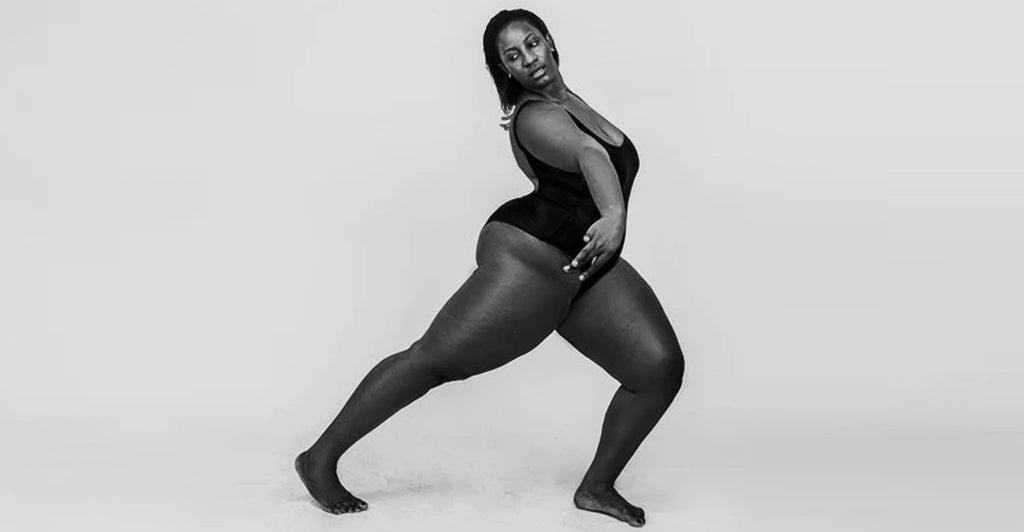By Kristen Jeré for Nappy Head Club
Curvy jeans are so important to me feeling confident in my body. The roomy hips. The more narrow waistline. The space to cross my legs and move them freely.
Since my weight gain (read: pandemic + second puberty) and the subsequent spreading of my hips, I hadn’t been able to wear any of my beloved baggy jeans for at least a couple of years. Most denim styles, regardless of how much I sized up, clung to my hips and thighs in a way that was uncomfortable at best.
I spent hours researching online in hopes of places that sell jeans spacious enough to accommodate the widening flesh of my thighs.
I purchased body measuring tape in an attempt to figure out my exact sizing, even though knowing my body that intimately–by the number–scared me immensely. At night, I tugged the cold, rubbery fabric tauntly against the bubble of my hips and counted the number that appeared in the mirror in front of me to the fourth of an inch.
When I finally discovered curvy jeans, it saved my self-esteem, which had been plummeting to a depth of body dysmorphia that I hadn’t known since I was a teenager.
But during the time that my body began to develop curves that somewhat mirrored what I saw often in social media being held up as the most desirable body type for women my age, I wondered why, for a shape that’s so popular, it’s so difficult to find clothing made for it.
And maybe part of that is due to the slim thick aesthetic’s slow but steady supposed fall from fame. The body type, typically characterized by a waist to hip ratio where the waist is dramatically smaller than the hips, has been the subject of a plethora of pop culture conversations since as early as 2015, along with being a coveted body type for many femmes.
But more recently, there’s been discussion on social media and other digital spheres that the BBL body type is not as popular as it used to be and will soon be a relic of pop culture’s past.
Celebrities like Kim Kardashian, who are unjustly given credit for popularizing (and even more so appropriating), the body type are rumored to have taken out the silicone implants, which are a popular option to obtain the BBL body type for those who don’t have the shape from their genetics and/or ancestry.
There are videos discussing the subtle but ongoing disappearance of BBL bodies from Instagram and other writers have written articles on the pop culture shift that predicts, and partially dangerously romanticizes, thin, waif-like bodies, popular in the 90s, coming back into the forefront of style. And in my own experience, I’ve noticed that one of my favorite websites to purchase curvy jeans no longer features models with wide hips, and full booties as the main image for their different curvy denim styles, but instead replaced them with images of the typical size two bodies that are the norm on most clothing websites.
To me, it’s jarring to experience such a drastic, yet slow, shift. When I’m looking up pilates videos on youtube, in hopes of slimming the parts of me that seem to grow bigger by the month, I still see rows of videos promising to eliminate hip dips, and give the viewer an hourglass figure–to create the magical appearance of a “side booty”.
And who can forget the infamously popular tik tok video from just last summer, where a flight from Miami had several Black women passengers who supposedly just had BBL surgery and were in too much discomfort to sit down?
But as we inevitably move on to the next “it” body type, it becomes necessary to think about who gets left behind from a cultural trend that was started by Black women, a lot of us by virtue of having curvier bodies through our ancestry, one that has been appropriated to such depths, to the point where a lot of people don’t even view it as such. And how will this shift impact those of us who continue to have these bodies beyond the “trends” of curvy shape wear and booty injections?
“To a lot of non-Black people, wide hips bring to mind this kind of stereotype of the ‘Jezebel’ or ‘temptress’–this sultry oversexualized Black woman,” said Jarnay, 25 (she/her). Part of the valid critique of BBL culture is how the aesthetic trend feeds into a hypersexualized stereotype of Black women, a bias that a lot of white people and non-black people hold. ”When non-black people get BBL’s, they’re not judged as harshly as Black women are,” said Jarnay.
This isn’t the only way that afrocentric features are often appropriated in pop culture as trends that non-Black people are praised for, “People tend to treat darker skin and full lips as a costume,” said Ebony, 25 (she/her).
In the past few years, we’ve seen countless examples of this type of featurism and colorism on social media and beyond while Black people who are further from eurocentric beauty standards continue to bear the brunt of prejudice and anti-blackness in our communities.
And in my experience with wide hips, you start to notice that mainstream industries don’t make products for people who look like you, similar to the way dark-skinned people have struggled to find foundation shades that match their skin tones.
The cultural decision to treat peoples ancestral features as trends, might also lead to vexing effects after these physicalities are no longer popular, but folks who are predisposed to these features continue to have them. “People [white hetero-patriarchy] use these certain trends going out of style to create competition between women and to look down on women who have these bodies that are then being deemed as ‘unattractive’,” said Jarnay.
But unlike people who utilize cosmetic tools such as lip fillers and hip augmentation, a lot of Black people will continue having these bodies without the option of removal once these trends go out of style.
Regarding Black womens’ curvy bodies as conventionally attractive only when we fit current trends creates an environment where Black women ultimately lose in the game of desirability politics, even when we temporarily gain approval of mainstream white gaze. And this whiplash effect isn’t just impacting curvy Black women.
As BBL culture has been popularized, a lot of Black women who don’t have curves, whether straight/thin bodied or fat Black women (who face their own set of prejudices against them due to fatphobia) are left to reckon with the constant feedback that their bodies are not desirable.
Non-binary and trans folks have also been impacted as a lot of gender affirming surgeries rely on the creation of traditional “femme” features, whose popularity is largerly in relation to what the ideal feminine shape is, defined by current cultural trends.
The slim thick, BBL “trend” has always relied on glamorizing curvier bodies at the detriment to other body types. Pretty privilege has been proven to impact how much more conventional attractive people are paid and other economic privileges. “The shape looks nice and it looks good, but it can be very limiting. There are people who don’t look that way,” said Ebony.
For Black women, the hips we carry with us are often reminders of our matriarchs. “I have the same shape as my mom,” said Jarnay. And for me, I think deeply of my mother and grandmother saying how my curves remind them exactly of my great grandmom, Mable: a petite Black woman with wide hips who “thought she was so cute” (words from my Granny).
I want to find ways to love my hips like my great granny loved hers, even knowing that soon, our society won’t affirm my shape in the same way.
And maybe in the midst of U.S. culture shifts around desirable bodies, some of the affirmation and belonging I desire comes most deeply from the community of women who look like me and will continue to be thick, curvy, slim-thick, and have fat asses. “We have the right bodies for the people we need,” said Jarnay, “You can never go out of style to someone who’s always liked what you have.”

About the Author:
Kristen Jeré is a writer, doula, and herbalist based in Chicago, IL.




JOIN THE DISCUSSION (0 comments)